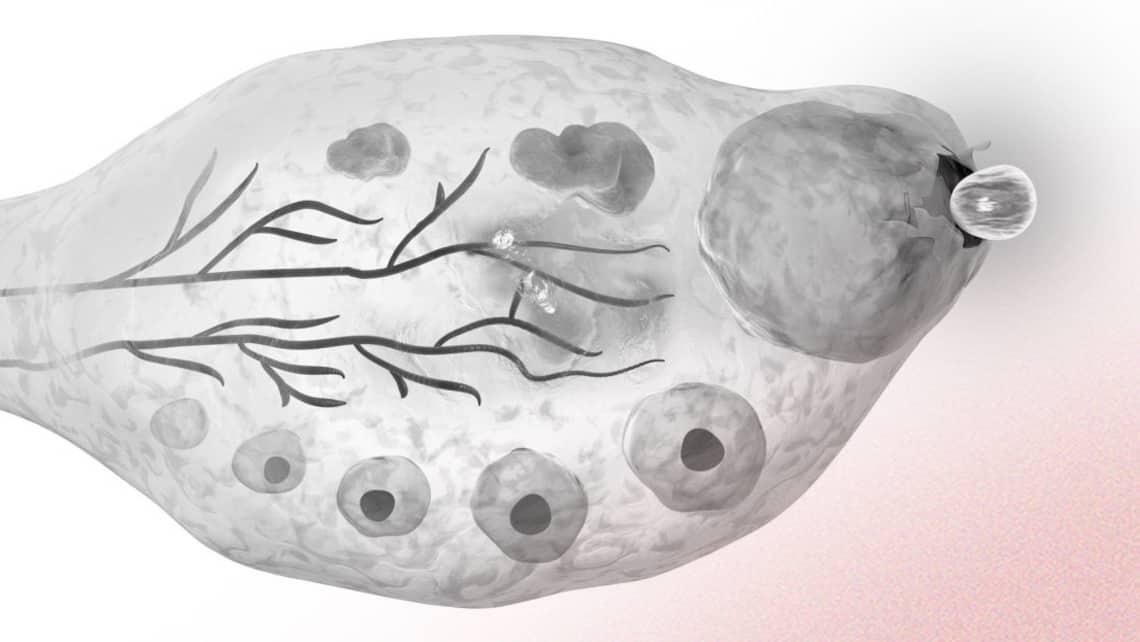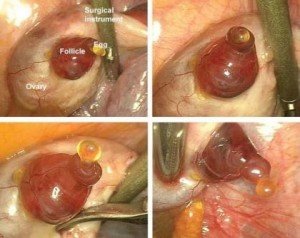
Ovulation
Ovulation is a process in which a mature egg (or oocyte) is released from the follicle that has developed in the ovary.
Índice
How does an ovulation occur?
A sequence of images of the actual process of ovulation was published in the prestigious journal New Scientist (see aside). We believe that knowing in detail how the oocyte is released from the ovarian follicle provides important information to couples seeking pregnancy or going to perform an In Vitro Fertilization (IVF) or Artificial Insemination cycle, so that at all times they will understand the process or will know where the problem lies in their case.

The photographs show the close-up of an egg emerging from an ovary and were taken by a Belgian doctor Jacques Donnez, who was performing a hysterectomy when he realized that the ovulation was taking place.
The images were possible to take since a mature egg is a big cell. It measures approximately 0.14 mm and is visible to the human eye.
Thanks to these images it has been discovered that, contrary to what we believed, the release of an egg is not a sudden and explosive event but rather a process, since it takes about 15 minutes.
Calculating ovulation when wishing to become pregnant
Once released, the egg is directed towards the uterus through the Fallopian tube with the mission of being fertilized by the sperm. Therefore, a woman’s fertile period includes not only the day of ovulation but also about 2 days before and 2 days after the approximate date of ovulation.
If you are looking for a pregnancy you have to match the sexual intercourse around that moment. In order to calculate the dates, you can use our ovulation calculator under the following link.
Symptoms associated with the ovulation
The ovulatory process can cause different physical changes. Each woman is unique and can experience them to a greater or lesser extent or, on the contrary, no symptom can appear too. Knowing these symptoms will make it easier to detect the moment of ovulation, and make sexual intercourse coincide with it in order to become pregnant.
Increased vaginal discharge
The cervical mucus does not only become more abundant. It also thickens, becomes more elastic and its whitish colour becomes more transparent. These features, which lead to it being defined as “egg white”, will make it easier for the sperm to make its way to the egg. These changes in the flow will be seen in the days preceding and during the ovulation itself.
Abdominal and/or lumbar pain similar to menstruation
The exit of an egg requires the opening of the follicle where it became mature. The expulsion of the egg is accompanied by the leak of follicular fluid, which is irritating to the peritoneum, causing discomfort in the lower abdomen and, more specifically, on the side corresponding to the ovary ovulating that month.
In addition, the ovulatory process requires contractions similar to those experienced during the period. This discomfort can also cause cramps and pain around the kidney or the back area.
Sudden emotional changes
The cause? The hormonal changes in the body.
Increased body temperature
The basal temperature (TBC) changes as the menstrual cycle progresses, being slightly lower in the first half and increasing around the ovulatory peak. By keeping a daily record of the temperature throughout the cycle, the time of ovulation can be known relatively well, always if the measurement is taken right upon waking up, after a minimum of 6 to 8 hours of sleep and without having made any effort.
Breast pain or increased sensitivity in the mammary glands
Liquid retention
Sometimes a general swelling can be seen and, consequently, a slight increase in weight and volume. Also other side effects linked to fluid retention are observed such as gas or increased thirst.
Increased sexual drive
We cannot forget that nature is very wise – ovulation also induces a greater libido. This makes sexual intercourse coincide when the egg releases and, overall, allows us to last as a species.
Ovulation in regular cycles
Normally, a woman with regular 28-day cycles is expected to ovulate every month around day 14 of the cycle, counting from the start of menstruation.
In women who have longer cycles that is, whose period starts more than 28 days after the previous one, the date of ovulation usually moves forward. The opposite happens in short cycles: if you have your period every 25 days, the ovulation will happen around day 11 or 12 of your cycle. Our ovulation calculator can help.[
Ovulation in irregular cycles
We consider the cycles as irregular when the number of days between each menstruation vary. One time they can be shorter and have less than 21 days or, another time, longer with more than 35 days.
The causes of irregular cycles are not always due to associated diseases (diabetes, eating disorders such as anorexia, thyroid endocrine problems[). Sometimes it is caused by emotional alterations such as stress or anxiety.
Phases of ovulation throughout a woman’s life
Women start to ovulate early in life, although the first cycles are often considered to be anovulatory (hence the menstrual irregularity of a woman at this period of her life). As she matures, her cycles become ovulatory and, therefore, more regular. Close to menopause[, ovulations are of worse quality and quantity, ceasing with the woman’s last menstrual periods.
Nowadays, one of the main concerns of infertile couples is to know if an adequate ovulation takes place and everything related to this event is of interest.
Links of interest:
